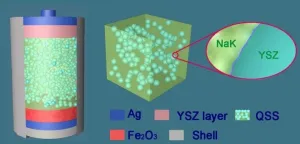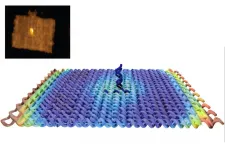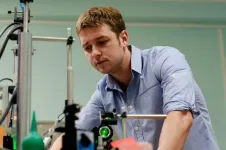Salt battery design overcomes bump in the road to help electric cars go the extra mile
2021-02-01
(Press-News.org) Using salt as a key ingredient, Chinese and British researchers have designed a new type of rechargeable battery that could accelerate the shift to greener, electric transport on our roads.
Many electric vehicles (EV) are powered by rechargeable lithium-ion batteries, but they can lose energy and power over time. Under certain conditions, such batteries can also overheat while working or charging, which can also degrade battery life and reduce miles per charge.
To solve these issues, the University of Nottingham is collaborating with six scientific research institutes across China to develop an innovative and affordable energy store with the combined performance merits of a solid-oxide fuel cell and a metal-air battery. The new battery could significantly extend the range of electric vehicles, while being fully recyclable, environmentally-friendly, low-cost and safe.
A solid-oxide fuel cell converts hydrogen and oxygen into electricity as a result of a chemical reaction. While they are highly-efficient at extracting energy from a fuel, durable, low-cost and greener to produce, they are not rechargeable. Meanwhile, metal-air batteries are electrochemical cells that uses a cheap metal such as iron and the oxygen present in air to generate electricity. During charging, they emit only oxygen into the atmosphere. Although not very durable, these high-energy dense batteries are rechargeable and can store and discharge as much electricity as lithium-ion batteries, but much more safely and cheaply.
In the early research phases, the research team explored a high-temperature, iron-air battery design that used molten salt as a type of electrolyte - activated by heat - for electrical conductivity. Cheap and inflammable, molten salts help to give a battery impressive energy storage and power capability and a lengthy lifecycle.
However, molten salts also possess adverse characteristics. University of Nottingham study lead, Professor George Chen said: "In extreme heat, molten salt can be aggressively corrosive, volatile and evaporate or leak, which is challenging to the safety and stability of battery design. There was an urgent need to fine-tune these electrolyte characteristics for better battery performance and to enable its future use in electric transport."
The researchers have now successfully improved the technology by turning the molten salt into soft-solid salt, using solid oxide nano-powders. Professor Jianqiang Wang, from the Shanghai Institute of Applied Physics, Chinese Academy of Sciences, who is leading this collaboration project has predicted that this quasi-solid-state (QSS) electrolyte is suitable for metal-air batteries which operate at 800 ºC; as it suppresses the evaporation and fluidity of the molten salts that can occur at such high operating temperatures.
Project collaborator, Dr Cheng Peng, also from the Shanghai Institute of Applied Physics, Chinese Academy of Sciences, explains a unique and useful design aspect of this experimental research. The quasi-solidification has been achieved using nanotechnology to construct a flexibly-connected network of solid oxide particles that act as a structural barrier locking in the molten salt electrolytes, while still allowing them to safely conduct electricity in extreme heat.
Professor Chen, who is leading a molten salt electrolysis laboratory in Nottingham, hopes the team's "encouraging results" will help to establish a simpler and more efficient approach to designing low-cost and high-performance molten salt metal-air batteries with high stability and safety.
He adds, "The modified molten salt iron-oxygen battery has great potential applications in new markets, including electric transport and renewable energy which require innovative storage solutions in our homes and at grid-level. The battery is also, in principle, capable of storing solar heat as well as electricity, which is highly-desirable for both domestic and industrial energy needs. Molten salts are currently used at large scale in Spain and China to capture and store solar heat which is then converted to electricity - our molten salt metal air battery does the two jobs in one device."
INFORMATION:
The full article, 'Quasi-solid-state electrolyte for rechargeable high-temperature molten salt iron-air battery', outlining the results, is published in the journal Energy Storage Materials.
More information is available from Professor George Chen, Professor of Electrochemical Technologies in the Faculty of Engineering on +44 (0) 1159514171 or George.chen@nottingham.ac.uk or Emma Lowry, Media Relations Manager (Engineering) on 0115 84 67156 or emma.lowry@nottingham.ac.uk
[Attachments] See images for this press release:

ELSE PRESS RELEASES FROM THIS DATE:
2021-02-01
The year 2020 played host to an uncharacteristically large number of natural disasters. The year began with large wildfires in the Amazon rainforest and Australia. A series of wildfires broke out in the American states of California during summer and Oregon in September 2020. In particular, the Oregon wildfire intensified to an uncontrollable extent and was spread over a wide area by strong gusts of wind that carried it forward. These unseasonably strong winds may have been stoked by an unexpected source: typhoons on the other side of the Pacific Ocean.
In late August and early September, three storms--Bavi, Mayask, and Haishen--occurred just two weeks apart in the Korean peninsula, causing floods, mudslides, and several casualties. In a recently ...
2021-02-01
T-cells are an important component of our immune system: with the receptors they carry on their surface, they can recognise highly specific antigens. Upon detection of an intruder, an immune response is triggered. It is still unclear exactly what happens when antigens are recognised: How many antigens are necessary to elicit an immune response, and does the response depend on their spatial arrangement?
These effects take place in the nanometer range - on the size scale of molecules, far below what can be seen with ordinary microscopes. To study all this, tiny tools are needed. Therefore, an unusual method was used at TU Wien: DNA molecules were folded in an ingenious way, similar to the paper folding ...
2021-02-01
Students from lower socio-economic groups (SEG) are less likely to participate in sport or physical activity at university, research from Sheffield Hallam University has found.
The main barriers affecting participation were found to be down to cost of being part of a sports team, lack of time due to academic commitments, part-time working or their social life taking precedence and limited prior knowledge of and participation in sport before starting university.
Funded by British Universities and Colleges Sport and published in the peer-reviewed Sport, Education and Society journal, the study surveyed over 700 students from 20 universities and found those that had participated in sport and physical ...
2021-02-01
A collaboration between the Pericàs group with Prof. Timothy Noël and Dr. Paola Riente at the Eindhoven University of Technology (TU/e, The Netherlands), has crystallised in a Nature Communications paper where they provide key insight into the chemical nature of the true photocatalyst involved in the Bi2O3-driven atom-transfer radical addition (ATRA) reaction.
Back in 2014, ICREA professors Miquel Pericàs and Emilio Palomares together with former postdoctoral researcher Dr. Riente published a paper on Angewandte Chemie International Edition pioneering the research on organic transformations in mild reactions conditions ...
2021-02-01
The work of the research group under the guidance of Professor Leonid Martyushev (co-authors: Roman Bando and Evgenia Chervontseva) will help to predict the behavior of fluids in various environments.
"When oil wells are depleted, water is pumped there under pressure to force the residual oil to the surface. If the interface between water and oil were an even layer, then it would be safe to say that as a result of water injection we recover all the residual oil. But since the interface between the two liquids is a highly distorted section, oil, contrary to expectations, can still remain underground, while water comes out to the surface. This is where our calculations come in ...
2021-02-01
The coronavirus crisis has led to some of the general public developing a critical view of the current food consumption model, as shown by a recent survey by the Catalan Consumer Agency, which reveals that 60.5% of all Catalans tend to think that the pandemic will promote more responsible, sustainable and fair consumption. Moreover, the various lockdowns have caused a significant increase in online shopping throughout Spain, with a 92% rise in volume and a 114.5% rise in value, according to aggregated consumption data from the Ministry of Agriculture, Fisheries and Food. This change in shopping habits and the awareness of the food model may also ...
2021-02-01
The human body strives to keep itself in homeostasis, or balance. When blood clots are created, the body's innate response is to break the clots down to prevent significant health problems from arising.
Research has found that patients with COVID-19 are prone to serious blood clotting. This is why many patients receive high dose anticoagulants as part of their treatment.
But a new study in Scientific Reports, led by senior author Daniel Lawrence, Ph.D., a Professor of Basic Research in Cardiovascular Medicine at Michigan Medicine, found that aside ...
2021-02-01
New research by Swansea University scientists found that boat ramps facilitate the dispersal of the highly invasive zebra mussel (Dreissena polymorpha).
To contain the dispersion of this invasive species Dr Marta Rodriguez-Rey and co-authors suggest in the new study, that strict control measures and target monitoring around boat ramps should be implemented.
Invasive bivalves are a problem as they can cause widespread environmental damage, and eradication has proved difficult. The zebra mussel is one of the most damaging invasive bivalves - it reproduces fast, disperses widely, and damages the economy. In Great Britain, £5 million are lost each year due to pipe fouling and damage to water infrastructures caused ...
2021-02-01
Titanium dioxide nanoparticles decorated by gold absorb about 96% of the solar spectrum and turn it into heat. The material can accelerate the evaporation in desalination plants up to 2.5 times and can track hazardous molecules and compounds. An international research team with representatives from Far Eastern Federal University (FEFU), ITMO University, and the Far Eastern Branch of the Russian Academy of Sciences, published a related article in ACS Applied Materials and Interfaces.
Access to safe water is included in the 17 UN Sustainable Development Goals. Meanwhile, the World Health Organization (WHO), and the Children's Fund (UNICEF) addressed the problem in 2019 report, noting that 2.2 ...
2021-02-01
In Rome lies the Santi Apostoli church, cared for by Franciscan brothers for more than 500 years. For more than 1500 years, this site has held the believed remains of two of the earliest Christians and Jesu apostles: St. Philip and St. James the Younger - relics of the Holy Catholic Church.
In the first few centuries of Christianity, life was difficult for the Christian minority, but gradually towards sixth century Christianity became the dominant religion and after Emperor Constantine on his deathbed declared Christianity the state religion, churches were erected all over the Roman Empire.
Shortly after the churches were erected, remains of worshipped Christian martyrs were moved from their ...
LAST 30 PRESS RELEASES:
[Press-News.org] Salt battery design overcomes bump in the road to help electric cars go the extra mile






